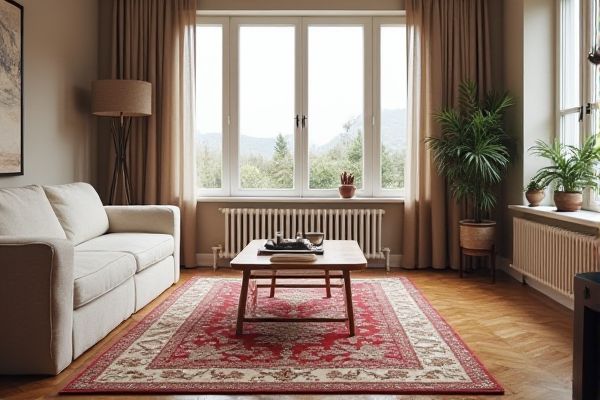
Accent rugs add a pop of color and style to any space, making them perfect for defining small areas or adding warmth to a room. Runner rugs, designed for hallways or narrow spaces, provide both function and aesthetic appeal, guiding your path while enhancing the decor; explore the rest of the article to discover which rug best suits your needs.
Table of Comparison
| Feature | Accent Rug | Runner Rug |
|---|---|---|
| Definition | Small to medium rug used as a decorative piece | Long, narrow rug designed for hallways or narrow spaces |
| Dimensions | Typically 2x3 to 5x8 feet | Typically 2-3 feet wide, 6-14 feet long |
| Purpose | Adds a pop of color or texture to rooms | Protects floors and guides foot traffic in narrow areas |
| Placement | Living rooms, bedrooms, under furniture or artwork | Hallways, entryways, kitchens, stairways |
| Design Variety | Wide range of styles and patterns | Often simpler patterns optimized for narrow shape |
| Functionality | Primarily decorative | Both functional and decorative |
Introduction to Accent Rugs and Runner Rugs
Accent rugs are small, decorative floor coverings designed to add color and texture to specific areas, enhancing your room's aesthetic without covering large spaces. Runner rugs are long, narrow rugs typically placed in hallways or staircases, providing both style and safety by protecting high-traffic floors. Choosing between an accent rug and a runner rug depends on the size and function of your space as well as the design impact you want to achieve.
Defining Accent Rugs: Purpose and Features
Accent rugs serve as versatile design elements that add warmth, color, and texture to any room without covering large floor areas. These smaller, decorative rugs highlight specific spots like under a coffee table or in front of a fireplace, enhancing the overall aesthetic and complementing your existing decor. Their varied shapes, patterns, and materials allow you to personalize your space while protecting floors in high-traffic zones.
Understanding Runner Rugs: Key Characteristics
Runner rugs are long, narrow rugs designed primarily for hallways, staircases, and entryways, offering both decorative and functional benefits. Made from durable materials such as wool, nylon, or polyester, runner rugs provide excellent protection for high-traffic areas while enhancing the space's aesthetic appeal. Their slim profile and varied lengths typically range from 2 to 3 feet wide and 6 to 14 feet long, making them ideal for tight or elongated spaces where an accent rug might not fit.
Common Sizes: Accent Rugs vs Runner Rugs
Accent rugs typically measure 3x5 feet or 4x6 feet, making them ideal for small areas such as living rooms or bedrooms. Runner rugs are longer and narrower, commonly sized between 2x6 feet and 3x10 feet, perfect for hallways and staircases. Understanding these common sizes helps you choose the right rug type to enhance your space's function and aesthetic.
Best Placement Areas for Accent Rugs
Accent rugs are best placed in small areas such as entryways, under coffee tables, or beside beds to add color and texture without overwhelming the space. Their moderate size makes them ideal for defining seating areas or highlighting decorative furniture pieces in living rooms or bedrooms. Unlike runner rugs, which suit narrow pathways like hallways or staircases, accent rugs enhance visual interest in compact zones.
Ideal Locations for Runner Rugs
Runner rugs are ideal for narrow, high-traffic areas such as hallways, staircases, and entryways, providing both style and protection for flooring. Their elongated shape fits perfectly in tight spaces where traditional rugs cannot, enhancing safety by reducing slips and cushioning footsteps. Durable materials and non-slip backing make runner rugs practical for kitchens and corridors, combining functionality with aesthetic appeal.
Design and Style Differences
Accent rugs typically feature bold patterns and vibrant colors to create focal points in rooms, while runner rugs are long and narrow, designed primarily for hallways or staircases to add style and protect flooring. Accent rugs can vary widely in shape and size, offering versatility in design placement, whereas runner rugs maintain a streamlined silhouette that complements narrow spaces. Your choice depends on the desired visual impact and functional use within your home's layout.
Material Choices and Durability
Accent rugs and runner rugs offer diverse material choices that impact their durability significantly. Accent rugs often come in cotton, wool, or synthetic fibers, providing softness and moderate wear resistance ideal for living areas. Runner rugs, frequently crafted from durable materials like polypropylene or nylon, are designed to withstand high foot traffic in hallways or staircases, ensuring longevity in busy spaces. Your choice should align with the rug's intended location and the expected level of use.
Cleaning and Maintenance Tips
Accent rugs require regular vacuuming and prompt spot cleaning to maintain their vibrant appearance, while runner rugs often demand more frequent attention in high-traffic areas to avoid dirt buildup. Using a mild detergent and avoiding harsh chemicals preserves fabric integrity and color in both types. Your choice between the two should consider ease of maintenance based on location and usage frequency.
How to Choose Between Accent Rug and Runner Rug
Choosing between an accent rug and a runner rug depends on your space and functionality needs; accent rugs are ideal for defining small areas or adding a pop of color, while runner rugs are designed for narrow, high-traffic corridors like hallways or staircases. Consider your room's dimensions and traffic flow to ensure the rug complements your existing decor and enhances comfort. Your decision should balance aesthetic appeal with practical use, ensuring the rug's size, shape, and style align with your home's layout.
 homyna.com
homyna.com